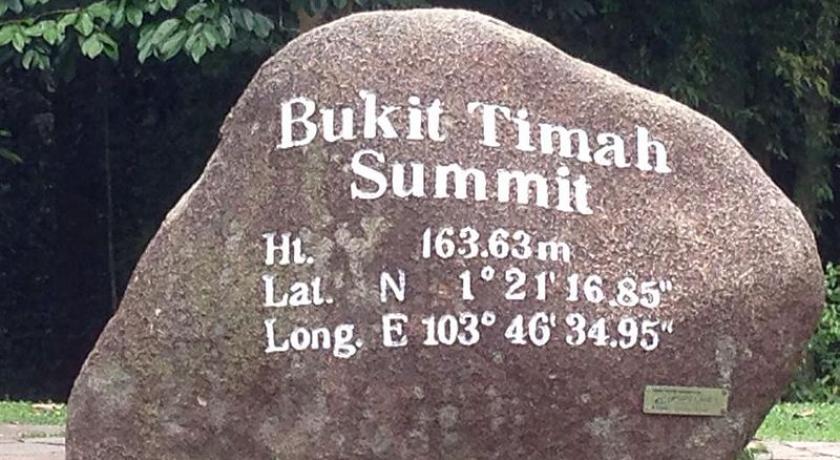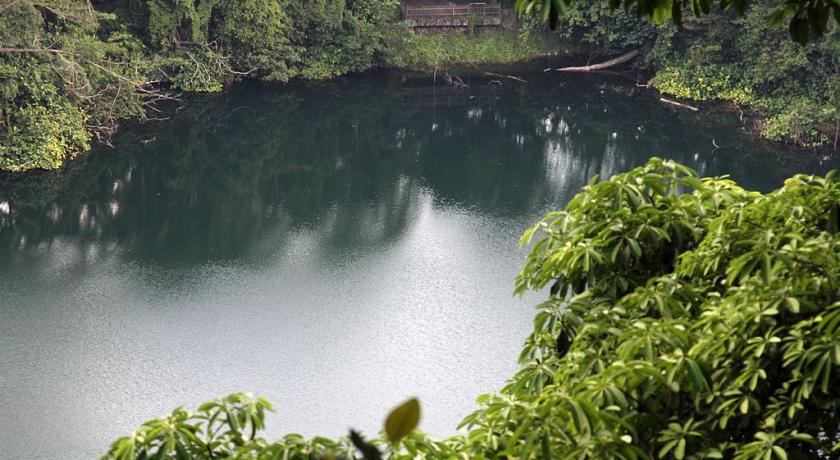Description
Bukit Timah Nature Reserve is a small 1.64 square kilometer (400 acre) nature reserve near the geographic centre of the city-state of Singapore, located on the slopes of Bukit Timah Hill, Singapore's highest hill standing at a height of 163.63 meters, and parts of the surrounding area. The nature reserve is about 12 kilometers from the Downtown Core, Singapore's central business district.
Despite its small size, it is considered one of the most productive pieces of nature. Alfred Russel Wallace also thought highly of the place. Together with the neighbouring Central Catchment Nature Reserve, it houses over 840 species of flowering plants and over 500 species of fauna. Today, it is one of the largest patches of primary rainforest left in Singapore. The forest reserve was formally declared as an ASEAN Heritage Park on 18 October 2011.
Etymology
The name Bukit Timah is borrowed from the tallest hill found in the area of the same name, which is also the tallest geographical location in all of Singapore. Bukit means hill in the Malay language, while Timah means tin, although tin deposits are not found in the area. The hill served as a granite quarry for many years, but since the mid-1900s, all operations of which has since been abandoned and converted into recreational areas and even filming locations.
The Eco-Link@BKE is an ecological bridge that spans the Bukit Timah Expressway, connecting Bukit Timah Nature Reserve and Central Catchment Nature Reserve. The first of its kind in Southeast Asia, its main purpose is to restore the ecological connection between two nature reserves, allowing wildlife to expand their habitat, genetic pool and survival chances.
Animals are very sensitive to smell, and are likely to shy away from using the bridge if there is a constant and heavy human scent in the area. Hence, Eco-Link@BKE is restricted to public access to minimise human disturbance to animals.
However, the bridge can accommodate occasional visits by researchers, surveyors and guided walks for the public.
History
In 1882, Nathaniel Cantley, then Superintendent of the Singapore Botanic Gardens, was commissioned by the Government of the Straits Settlements to prepare a report on the forests of the settlements. On Cantley's recommendation, several forest reserves were created on Singapore Island over the next few years. Bukit Timah was one of the first forest reserves established in 1883.
All the reserves were worked for timber with the exception of Bukit Timah Reserve. By 1937, the forest reserves were depleted under economic pressures for development. However, three areas, including the Bukit Timah Reserve, were retained for the protection of flora and fauna under the management of the Singapore Botanic Gardens.
In 1951, further protection of the reserves were provided by the enactment of a Nature Reserves Ordinance and the establishment of a Nature Reserves Board for the administration of the reserves, now designated as nature reserves, which total some 28 square kilometers in area.
Today, the nature reserves are set aside for the propagation, protection and preservation of the indigenous flora and fauna of Singapore under the National Parks Act and are managed by the National Parks Board.
Recreation
The primary activities at Bukit Timah are strolling, running and hiking. There are also smaller groups of people who rock-climb and abseil at the Dairy Farm quarry as well as mountain biking. There are specially-allocated mountain-bike trails around the area and Bukit Timah Mountain Bike (MTB) Trail is located within the Reserve. The 6.5 KM MTB trail loops around Bukit Timah Hill and is stretched between Hinhinde Park and Dairy Farm Road. The trail represents a tropical rocky terrain with extended technical climbs and difficult descent at short intervals. For MTB Map trail rating, it is largely made up of black diamond sections with intermittent blue square sections. There are also short alternative double black diamond sections.
The Reserve is popular among athletes training for mountain-climbing. There are a number of hiking trails. The blue trail is rated as "easy" and is 0.7 kilometers (0.43 mi) long, ending overlooking Hindhede Quarry. The red trail is also rated as "easy" and is 1.2 kilometers (0.75 mi) long. The green trail is rated as "moderate to difficult" and is 1.9 kilometers (1.2 mi) long. The yellow trail is rated as "difficult" and is 1.8 kilometers (1.1 mi) long. The red, green and yellow trails all end at the hut at the summit of Bukit Timah hill.
Wildlife
Naturalists also treasure Bukit Timah for its variety of plants and animals. Some of the common plants there are the rattan, figs, and macaranga. Two meninjau trees (Gnetum gnemon) stand near the visitor center. 18 different species of dipterocarps live in the reserve, including the seraya (Shorea curtisii) and Dipterocarpus caudatus. Fan palms(Licuala ferruginea), leaf litter plants (Agrostistachys longifolia) thorny rattan and ferns are also common. Fern species include staghorn fern (Platycerium coronarium) and bird’s nest fern (Asplenium nidus). Lichens and fungus, such as bracket fungus are also found.
Common animals include millipedes, carpenter bees, and many different types of bird, insects and spiders. Common insect species include cicadas and giant forest ants (Camponotus gigas). Common spider species include the golden orb-web spider (Nephila pilipes) and the St Andrew's Cross spider (Argiope mangal). The Singapore freshwater crab (Johora singaporensis) is indigenous to Bukit Timah. Reptiles in the reserve include the reticulated python (Python reticulatus), the paradise tree snake (Chrysopelea paradisi) and the common sun skink (Eutropis multifasciata).
The greater racket-tailed drongo is one of the most common birds at Bukit Timah (Dicrurus paradiseus). The drongos often follow monkeys through the forest and eat insects that are exposed by the monkeys' actions. Other bird species include the Asian fairy bluebird (Irena puella), the red-crowned barbet (Megalaima rafflesii) and the emerald dove (Chalcophaps indica). Bukit Timah is one of only two places in Singapore where the red-crowned barbet is found, the other being the Central Catchment Nature Reserve. The reserve, along with the adjacent Central Catchment Nature Reserve, has been identified by BirdLife International as the Central Forest Important Bird Area (IBA) because it supports populations of vulnerable straw-headed bulbuls and brown-chested jungle flycatchers.
The crab-eating macaque (Macaca fascicularis), a species of monkey, is common in the reserve. The monkeys also enter the area surrounding the park and are common enough that there are concerns that interactions with people will alter their behavior. Feeding the monkeys is prohibited, and visitors are urged to avoid staring at, baring teeth at or otherwise disturbing or threatening the monkeys. Monkeys are not the only mammals in the park. Other mammals include the Malayan pangolin (Manis javanica), Malayan colugo (Galeopterus variegatus), plantain squirrel (Callosciurus notatus) and slender squirrel (Sundasciurus tenuis). The colugos, which are generally nocturnal, can sometimes be seen clinging to trees during the day. Bukit Timah is the only place in Singapore where the red-cheeked flying squirrel (Hylopetes spadiceus) is found.
The banded leaf monkey (Presbytis femoralis) was once found in Bukit Timah but the last individual from the Bukit Timah population died in 1987.
Notices
For your safety, public access to the Bukit Timah Nature Reserve (BTNR) will be limited for about two years, with effect from 15 September 2014 as NParks carries out repair and restoration works to the slopes, trails and forests in the reserve. NParks will also use the opportunity to upgrade its more than 20-year old visitor centre at the foot of BTNR. For safety reasons, we are unable to accede to requests for hiking permits at BTNR.
Opening hours:
Saturdays and Sundays only
7am to 6pm (Last entry 5pm)
Bukit Timah Nature Reserve Visitors Centre
Address: Hindhede Dr, Singapore 589318
Phone: +65 1800 471 7300
Accessibility info: No wheelchair/prams access
Smoke-free park
Source https://en.wikipedia.org/wiki/Bukit_Timah_Nature_Reserve
Address
Singapore
Singapur
Lat: 1.348392487 - Lng: 103.777465820





